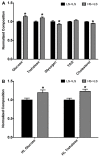Evidence for transgenerational metabolic programming in Drosophila
- PMID: 23649823
- PMCID: PMC3759332
- DOI: 10.1242/dmm.011924
Evidence for transgenerational metabolic programming in Drosophila
Abstract
Worldwide epidemiologic studies have repeatedly demonstrated an association between prenatal nutritional environment, birth weight and susceptibility to adult diseases including obesity, cardiovascular disease and type 2 diabetes. Despite advances in mammalian model systems, the molecular mechanisms underlying this phenomenon are unclear, but might involve programming mechanisms such as epigenetics. Here we describe a new system for evaluating metabolic programming mechanisms using a simple, genetically tractable Drosophila model. We examined the effect of maternal caloric excess on offspring and found that a high-sugar maternal diet alters body composition of larval offspring for at least two generations, augments an obese-like phenotype under suboptimal (high-calorie) feeding conditions in adult offspring, and modifies expression of metabolic genes. Our data indicate that nutritional programming mechanisms could be highly conserved and support the use of Drosophila as a model for evaluating the underlying genetic and epigenetic contributions to this phenomenon.
Figures







References
-
- Aguila J. R., Suszko J., Gibbs A. G., Hoshizaki D. K. (2007). The role of larval fat cells in adult Drosophila melanogaster. J. Exp. Biol. 210, 956–963 - PubMed
-
- Andres A. J., Thummel C. S. (1994). Methods for quantitative analysis of transcription in larvae and prepupae. Methods Cell Biol. 44, 565–573 - PubMed
-
- Backhaus B. S. E., Sulkowski E., Schlote F. W. (1984). A semi-synthetic, general-purpose medium for Drosophila melanogaster. Drosoph. Inf. Serv. 60, 210–212
Publication types
MeSH terms
Substances
Grants and funding
LinkOut - more resources
Full Text Sources
Other Literature Sources
Molecular Biology Databases

